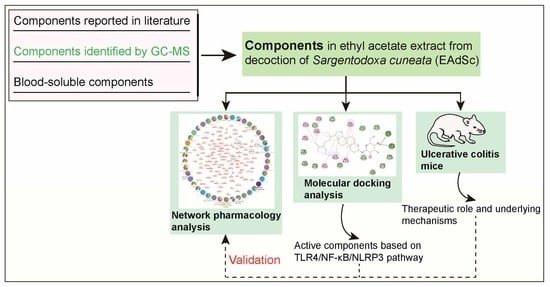Anti-Ulcerative Colitis Effects and Active Ingredients in Ethyl Acetate Extract from Decoction of Sargentodoxa cuneata
Abstract
:1. Introduction
2. Results
2.1. Components of EAdSc Reported in the Literature and Those Identified by GC–MS
2.2. Identification of Blood-Soluble EAdSc Components
2.3. Network Analysis Results
2.4. EAdSc Compounds Potentially Effective through the TLR4/NF-κB/NLRP3 Pathway
2.5. EAdSc Ameliorated DSS-Induced UC Symptoms in Mice
2.6. EAdSc Attenuated Histopathological Injury in Mice with DSS-Induced UC
2.7. EAdSc Inhibited Inflammation in Colon Tissues of Mice with DSS-Induced UC
2.8. EAdSc Decreased the Expression of TLR4, NF-κB p65, NLRP3, and Caspase-1 mRNA in Colon Tissues of Mice with UC
3. Discussion
4. Materials and Methods
4.1. Chemicals and Reagents
4.2. Plant Material and Preparation of EAdSc
4.3. Animals
4.4. Chemical Profiling of EAdSc
4.4.1. Identification of EAdSc Components by GC–MS
4.4.2. Chemical Profiling of Plasma Obtained after EAdSc Administration
4.5. Network Pharmacology Analysis
4.6. Molecular Docking
4.7. Pharmacodynamic Evaluation and Validation of the Mechanism of EAdSc for the Treatment of UC
4.7.1. Induction of UC in Mice and Subsequent Treatment
4.7.2. Disease Activity Index (DAI) and Colon Macroscopic Damage Index (CMDI)
4.7.3. Histological Examination
4.7.4. ELISA Analysis
4.7.5. Experimental Validation of RT-PCR Analysis
4.8. Statistical Analysis
5. Conclusions
Supplementary Materials
Author Contributions
Funding
Institutional Review Board Statement
Informed Consent Statement
Data Availability Statement
Conflicts of Interest
References
- Taku, K.; Britta, S.; Chen, W.S.; Ferrante, M.; Shen, B.; Bernstein, C.N.; Silvio, D.; Laurent, P.-B.; Toshifumi, H. Ulcerative colitis (primer). Nat. Rev. Dis. Primers 2020, 6, 74. [Google Scholar]
- Losa, A.; Gomes, R.; Mourão, F.R.; Cardoso, S.S.; Vieira, P.M.; Correia, M.R.; Silva, H.M.; Silva, G.; Tavares, M.; Silva, E.S.; et al. Drug-Related Adverse Reactions in Pediatric Inflammatory Bowel Disease. J. Clin. Pharmacol. 2023. [Google Scholar] [CrossRef] [PubMed]
- Hindryckx, P.; Jairath, V.; D’haens, G. Acute severe ulcerative colitis: From pathophysiology to clinical management. Nat. Rev. Gastroenterol. Hepatol. 2016, 13, 654–664. [Google Scholar] [CrossRef] [PubMed]
- Tambuwala, M.M. Natural nuclear factor kappa beta inhibitors: Safe therapeutic options for inflammatory bowel disease. Inflamm. Bowel Dis. 2016, 22, 719–723. [Google Scholar] [CrossRef]
- Liu, Y.; Li, B.-G.; Su, Y.-H.; Zhao, R.-X.; Song, P.; Li, H.; Cui, X.-H.; Gao, H.-M.; Zhai, R.-X.; Fu, X.-J. Potential activity of traditional Chinese medicine against ulcerative colitis: A review. J. Ethnopharmacol. 2022, 289, 115084. [Google Scholar] [CrossRef]
- Zhang, W.; Sun, C.; Zhou, S.; Zhao, W.; Wang, L.; Sheng, L.; Yi, J.; Liu, T.; Yan, J.; Ma, X. Recent advances in chemistry and bioactivity of Sargentodoxa cuneata. J. Ethnopharmacol. 2021, 270, 113840. [Google Scholar] [CrossRef] [PubMed]
- Commission, S.P. Chinese Pharmacopoeia (Part I); China Pharmaceutical Science and Technology Press: Beijing, China, 2020. [Google Scholar]
- Guo, S.; Wang, S.; Mao, R.; Li, Z.; Wang, H. Effects of Gegen Hongteng Jiedu Decoction on TRL4 and serum interleukin-10 in colon tissue of rats with ulcerative colitis. Zhonghua J. Tradit. Chin. Med. 2020, 35, 2050–2052. [Google Scholar]
- Li, M.; Ren, R.; Duan, R.; Meng, C.; He, X.; Wen, S.; You, S.; Wang, Y.; Li, Z. Pharmacodynamics of Fufang Hongteng Granules. Chin. Pat. Med. 2016, 38, 2546–2550. [Google Scholar]
- Liu, L.H.; Cao, Z.W. Protective effect and mechanism of Hongteng Decoction on ulcerative colitis in mice. Chin. J. Surg. Integr. Tradit. West. Med. 2020, 26, 232–236. [Google Scholar]
- Zhu, J.; Zhou, Z. Zhou Zhenghua’s experience in treating ulcerative colitis. Hunan J. Tradit. Chin. Med. 2015, 31, 42–43. [Google Scholar]
- Zhang, Z.; Yang, L.; Wang, B.; Zhang, L.; Zhang, Q.; Li, D.; Zhang, S.; Gao, H.; Wang, X. Protective role of liriodendrin in mice with dextran sulphate sodium-induced ulcerative colitis. Int. Immunopharmacol. 2017, 52, 203–210. [Google Scholar] [CrossRef]
- Li, D.; Zhuo, Y.; Zhang, Q.; Zhang, L.; Zhang, S.; Lv, Y.; Li, C.; Cui, L.; Guan, X.; Yang, L. Purification of 3, 4-dihydroxyphenylethyl alcohol glycoside from Sargentodoxa cuneata (Oliv.) Rehd. et Wils. and its protective effects against DSS-induced colitis. Sci. Rep. 2019, 9, 3222. [Google Scholar] [CrossRef] [PubMed]
- Chen, X.; Feng, T.; Yang, Z.; Guan, J.; Wang, H.; Zhao, D.; Zhao, Z.; Zhou, Y. Protective effects of different polar parts of Rhizoma Daxueteng on H2O2-injured osteoblasts. Chin. J. Osteoporos. 2017, 23, 291–297. [Google Scholar]
- Zhan, X.; Pei, J.; Fan, W.; Huang, S.; Du, R.; Jiang, M. Chemical constituents from ethyl acetate extract of Sargentodoxa cuneata Rattans. J. Chin. Med. Mater. 2022, 45, 1114–1118. [Google Scholar]
- Mao, S.; Gu, Q.; Cui, C.; Han, B.; Cai, B.; Liu, H. Phenolic chemical constituents in the Chinese medicine Dahuangteng and their antitumor activities. Chin. J. Med. Chem. 2004, 14, 326–330. [Google Scholar]
- Wang, Y.; Zhang, B.; Liu, S.; Xu, E.; Wang, Z. The traditional herb Sargentodoxa cuneata alleviates DSS-induced colitis by attenuating epithelial barrier damage via blocking necroptotic signaling. J. Ethnopharmacol. 2023, 117373. [Google Scholar] [CrossRef]
- Xu, F.; Huang, X.; Zhang, M.; Wang, X.; Wu, H. Study on the anti-inflammatory mechanism of Sargentodoxa cuneata based on network pharmacology. Chin. Arch. Tradit. Chin. Med. 2020, 38, 249–253+287. [Google Scholar]
- Liu, B.; Zheng, X.; Li, J.; Li, X.; Wu, R.; Yang, J.; Liu, W.; Zhao, G. Revealing mechanism of Caulis Sargentodoxae for the treatment of ulcerative colitis based on network pharmacology approach. Biosci. Rep. 2021, 41, BSR20204005. [Google Scholar] [CrossRef]
- Kong, L.; Sun, Y.; Sun, H.; Zhang, A.-H.; Zhang, B.; Ge, N.; Wang, X.-J. Chinmedomics strategy for elucidating the pharmacological effects and discovering bioactive compounds from keluoxin against diabetic retinopathy. Front. Pharmacol. 2022, 13, 728256. [Google Scholar] [CrossRef]
- Dai, Y.; Lu, Q.; Li, P.; Zhu, J.; Jiang, J.; Zhao, T.; Hu, Y.; Ding, K.; Zhao, M. Xianglian Pill attenuates ulcerative colitis through TLR4/MyD88/NF-κB signaling pathway. J. Ethnopharmacol. 2023, 300, 115690. [Google Scholar] [CrossRef]
- Yu, Y.; Yu, F.; Feng, J.; Shen, F.; Yu, B.; Chen, Q.; Shi, L.; Bian, Y. Research on the therapeutic mechanism of Sargentgloryvine Stem on CIA rats based on NF-κB/NLRP3 pathway. J. Nanjing Univ. Tradit. Chin. Med. 2021, 37, 396–399. [Google Scholar]
- Hu, J.; Huang, H.; Che, Y.; Ding, C.; Zhang, L.; Wang, Y.; Hao, H.; Shen, H.; Cao, L. Qingchang Huashi Formula attenuates DSS-induced colitis in mice by restoring gut microbiota-metabolism homeostasis and goblet cell function. J. Ethnopharmacol. 2021, 266, 113394. [Google Scholar] [CrossRef] [PubMed]
- Cao, Q.; Gao, X.; Lin, Y.; Yue, C.; Wang, Y.; Quan, F.; Zhang, Z.; Liu, X.; Lu, Y.; Zhan, Y. Thymopentin ameliorates dextran sulfate sodium-induced colitis by triggering the production of IL-22 in both innate and adaptive lymphocytes. Theranostics 2019, 9, 7490. [Google Scholar] [CrossRef] [PubMed]
- Qu, S.; Fan, L.; Qi, Y.; Xu, C.; Hu, Y.; Chen, S.; Liu, W.; Liu, W.; Si, J. Akkermansia muciniphila alleviates dextran sulfate sodium (DSS)-induced acute colitis by NLRP3 activation. Microbiol. Spectr. 2021, 9, e00730-21. [Google Scholar] [CrossRef] [PubMed]
- Hua, Y.; Liu, R.; Lu, M.; Guan, X.; Zhuang, S.; Tian, Y.; Zhang, Z.; Cui, L. Juglone regulates gut microbiota and Th17/Treg balance in DSS-induced ulcerative colitis. Int. Immunopharmacol. 2021, 97, 107683. [Google Scholar] [CrossRef]
- Sheng, K.; Xu, Y.; Kong, X.; Wang, J.; Zha, X.; Wang, Y. Probiotic Bacillus cereus alleviates dextran sulfate sodium-induced colitis in mice through improvement of the intestinal barrier function, anti-inflammation, and gut microbiota modulation. J. Agric. Food Chem. 2021, 69, 14810–14823. [Google Scholar] [CrossRef]
- Zhang, H.; Deng, A.; Zhang, Z.; Yu, Z.; Liu, Y.; Peng, S.; Wu, L.; Qin, H.; Wang, W. The protective effect of epicatechin on experimental ulcerative colitis in mice is mediated by increasing antioxidation and by the inhibition of NF-κB pathway. Pharmacol. Rep. 2016, 68, 514–520. [Google Scholar] [CrossRef]
- Kim, D.-H.; Han, S.-I.; Go, B.; Oh, U.H.; Kim, C.-S.; Jung, Y.-H.; Lee, J.; Kim, J.-H. 2-methoxy-4-vinylphenol attenuates migration of human pancreatic cancer cells via blockade of fak and akt signaling. Anticancer Res. 2019, 39, 6685–6691. [Google Scholar] [CrossRef]
- Lee, H.A.; Song, Y.R.; Park, M.H.; Chung, H.Y.; Na, H.S.; Chung, J. Catechin ameliorates Porphyromonas gingivalis-induced inflammation via the regulation of TLR2/4 and inflammasome signaling. J. Periodontol. 2020, 91, 661–670. [Google Scholar] [CrossRef]
- Liu, X.; Zhou, M.; Dai, Z.; Luo, S.; Shi, Y.; He, Z.; Chen, Y. Salidroside alleviates ulcerative colitis via inhibiting macrophage pyroptosis and repairing the dysbacteriosis-associated Th17/Treg imbalance. Phytother. Res. 2023, 37, 367–382. [Google Scholar] [CrossRef]
- Wang, J.; Zhang, C.; Guo, C.; Li, X. Chitosan ameliorates DSS-induced ulcerative colitis mice by enhancing intestinal barrier function and improving microflora. Int. J. Mol. Sci. 2019, 20, 5751. [Google Scholar] [CrossRef] [PubMed]
- Xie, Q.; Li, H.; Ma, R.; Ren, M.; Li, Y.; Li, J.; Chen, H.; Chen, Z.; Gong, D.; Wang, J. Effect of Coptis chinensis franch and Magnolia officinalis on intestinal flora and intestinal barrier in a TNBS-induced ulcerative colitis rats model. Phytomedicine 2022, 97, 153927. [Google Scholar] [CrossRef] [PubMed]
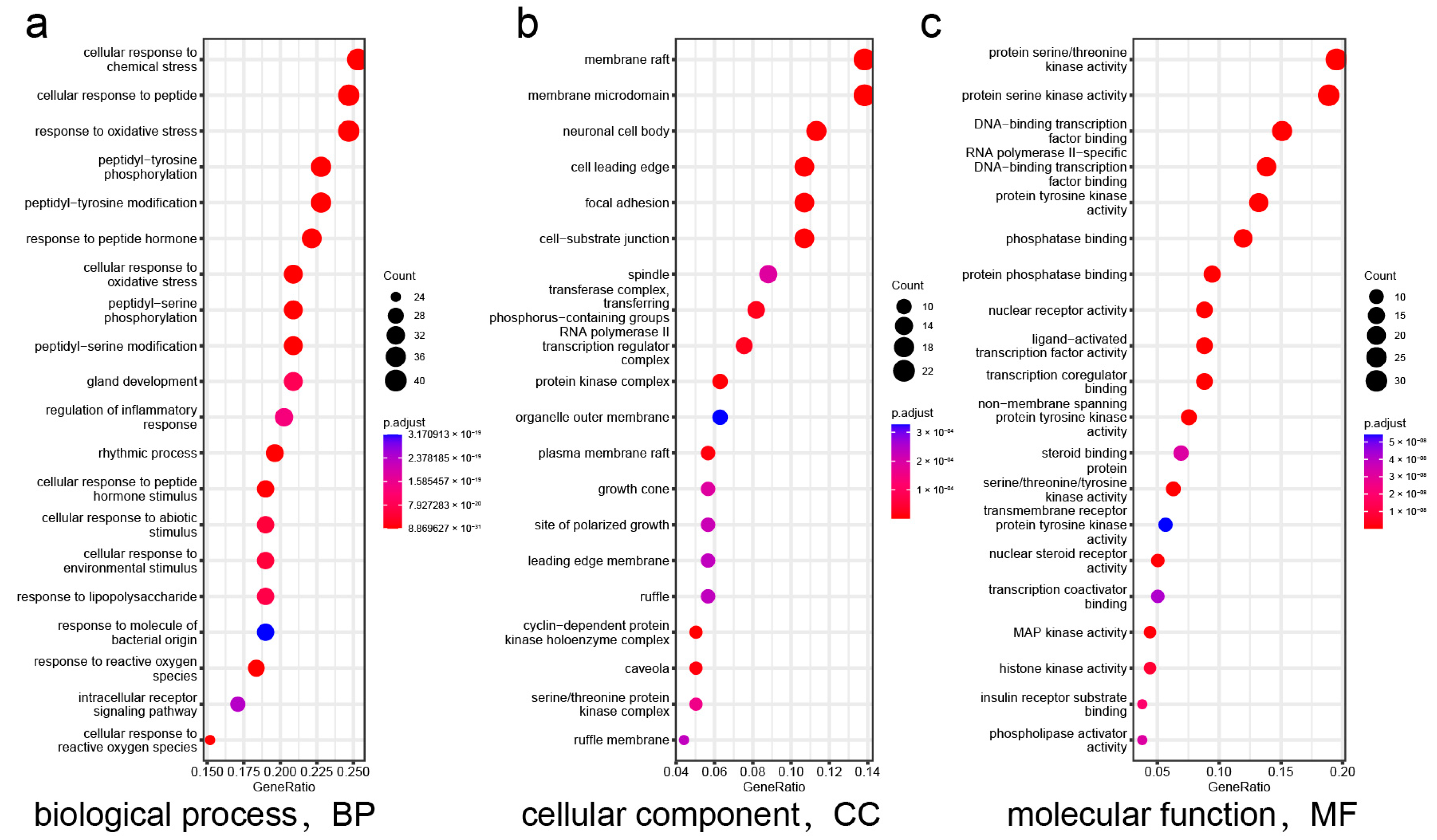

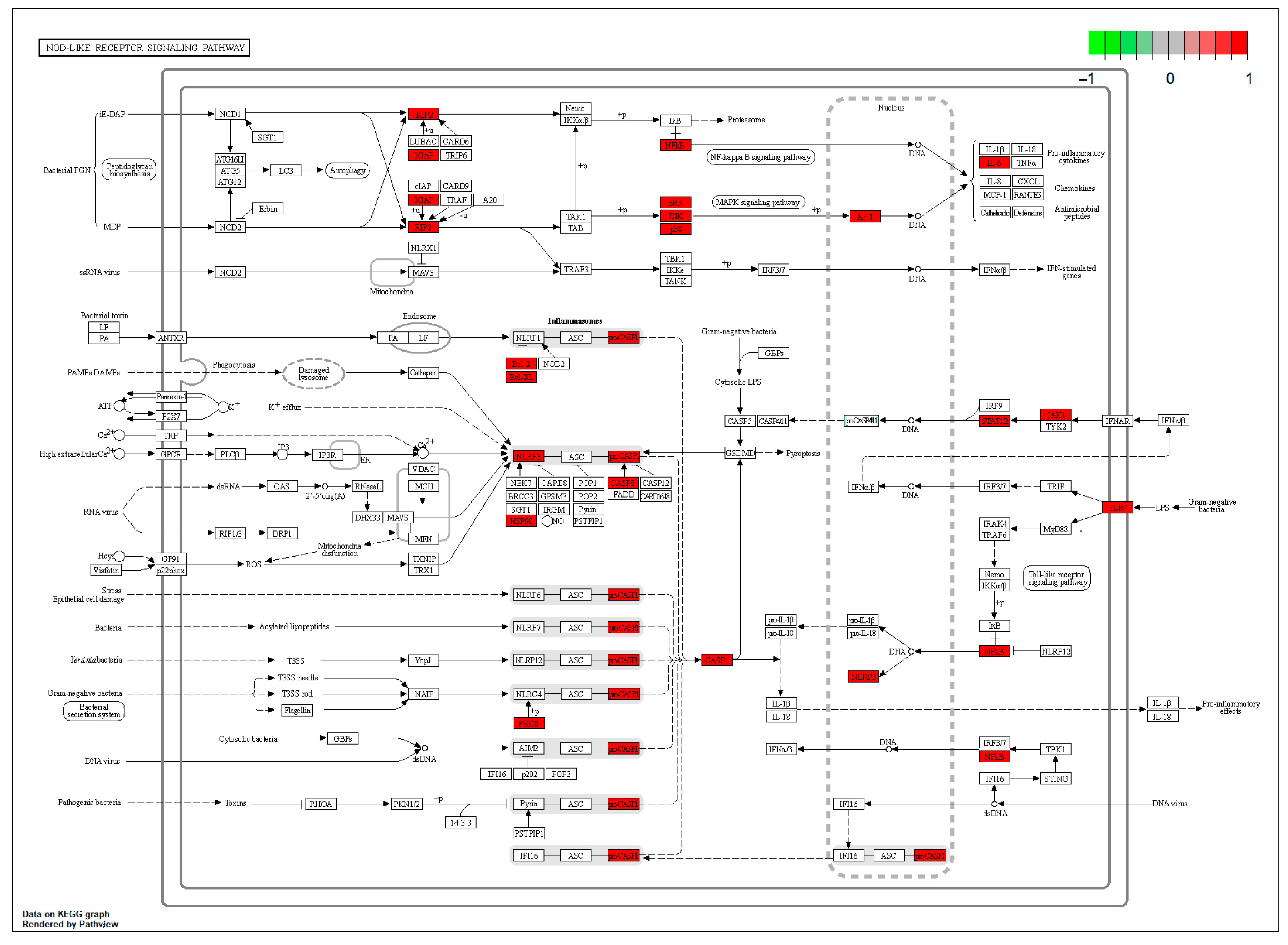
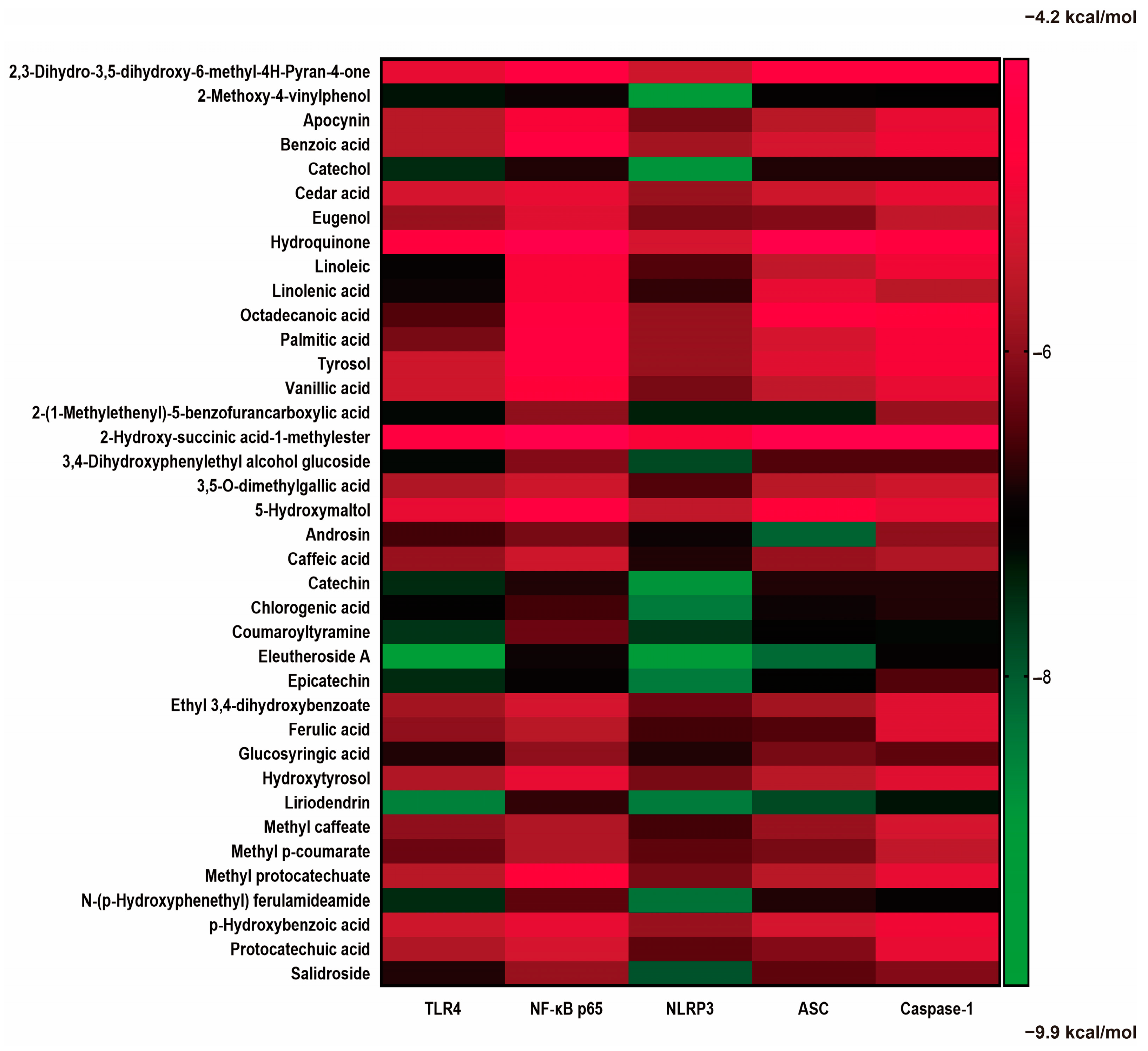


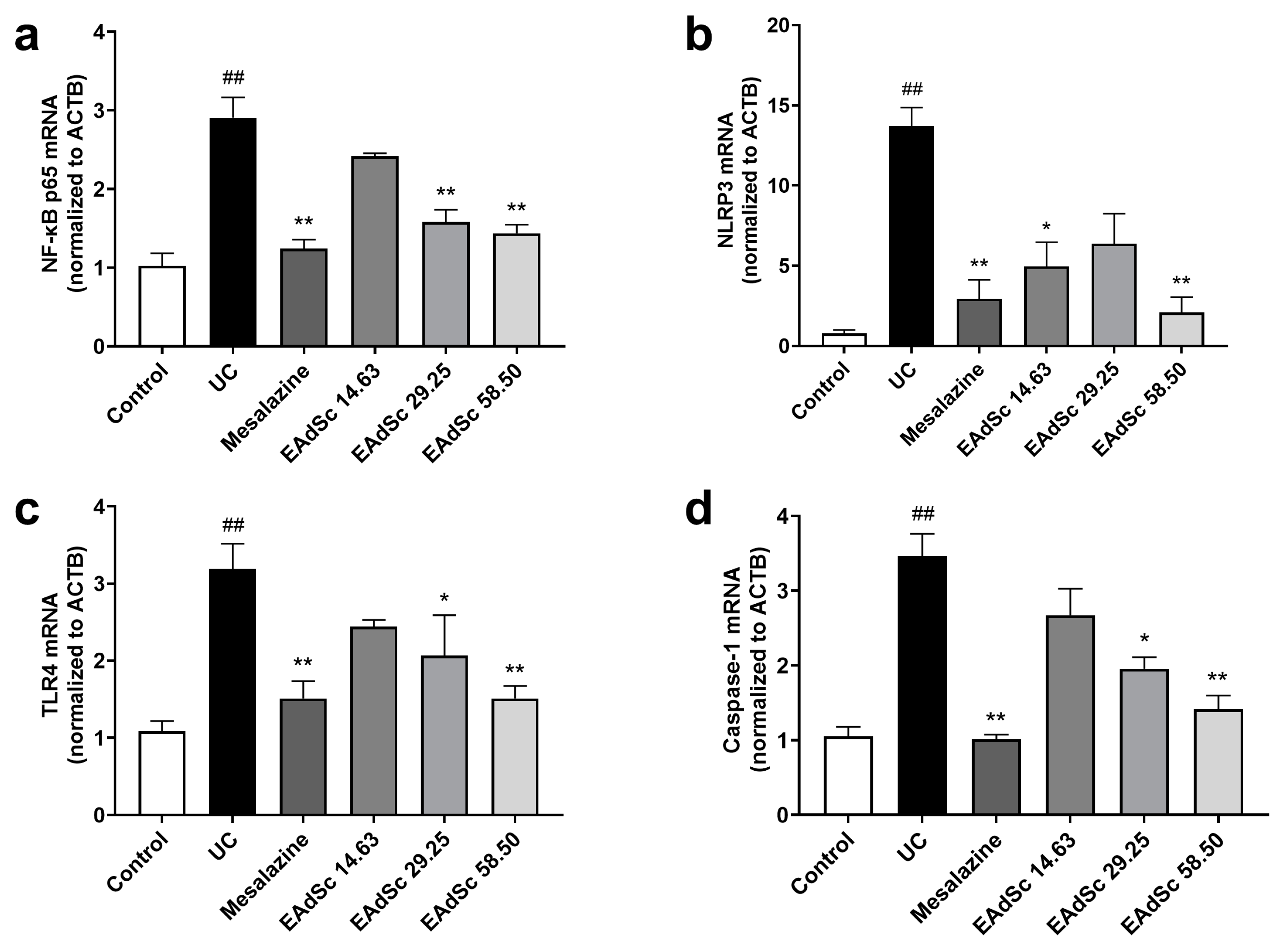
| Retention Time (min) | Compound | Molecular Weight | Percentage (%) |
|---|---|---|---|
| 7.753 | Propanoic acid, ethyl ester | 102.07 | 2.441938 |
| 9.485 | Toluene | 92.06 | 0.119818 |
| 10.662 | Hexanal | 100.09 | 0.209041 |
| 11.059 | Acetic acid, butyl ester | 116.08 | 6.236906 |
| 13.052 | Ethylbenzene | 106.08 | 0.097175 |
| 13.381 | p-Xylene | 106.08 | 0.234868 |
| 14.336 | Cyclohexanone | 98.07 | 4.841384 |
| 25.542 | 2,3-Dihydro-3,5-dihydroxy-6-methyl-4H-Pyran-4-one | 144.04 | 10.60658 |
| 26.783 | dihydro-4-hydroxy-2(3H)-Furanone | 102.03 | 0.305965 |
| 26.87 | Benzoic acid | 122.04 | 0.772141 |
| 27.55 | 3,5-Dihydroxy-2-methyl-4H-Pyran-4-one | 142.03 | 1.080466 |
| 28.758 | Catechol | 110.04 | 4.13385 |
| 31.517 | Hydroquinone | 110.04 | 0.778671 |
| 32.552 | 2-Methoxy-4-vinylphenol | 150.07 | 2.0374 |
| 33.993 | 2,6-Dimethoxy-phenol | 154.06 | 0.500634 |
| 34.193 | Eugenol | 164.08 | 0.290604 |
| 36.913 | 4-Hydroxy-benzeneethanol | 138.07 | 9.224397 |
| 39.02 | Apocynin | 166.06 | 3.120635 |
| 41.609 | 4-Ethenyl-2,6-dimethoxy-phenol | 180.08 | 0.470446 |
| 41.849 | Vanillic acid | 168.04 | 2.444373 |
| 43.116 | 3,4,5-Trimethoxy-phenol | 184.07 | 0.866043 |
| 47.176 | 1-(4-Hydroxy-3,5-dimethoxyphenyl)-Ethanone | 196.07 | 0.199561 |
| 49.71 | 4-Hydroxy-3,5-dimethoxy-benzoic acid | 198.05 | 0.369855 |
| 53.374 | n-Hexadecanoic acid | 256.24 | 0.721303 |
| 56.987 | 9,12-Octadecadienoic acid (Z, Z)- | 280.24 | 0.543 |
| 57.117 | 9,12,15-Octadecatrienoic acid, (Z, Z, Z)- | 278.23 | 0.765977 |
| 57.451 | Octadecanoic acid | 284.27 | 0.068583 |
| 66.239 | Octacosane | 394.45 | 0.338781 |
| 68.751 | Triacontane | 422 | 0.144914 |
| Compounds | TLR4 | p65 | NLRP3 | ASC | Caspase-1 |
|---|---|---|---|---|---|
| 2,3-Dihydro-3,5-dihydroxy-6-methyl-4H-pyran-4-one | −5.1 | −4.5 | −5.4 | −4.6 | −4.6 |
| 2-Methoxy-4-vinylphenol | −7.3 | −6.9 | −9 | −7 | −7.1 |
| Apocynin | −5.6 | −4.9 | −6.2 | −5.6 | −5.1 |
| Benzoic acid | −5.6 | −4.5 | −5.8 | −5.3 | −5 |
| Catechol | −7.5 | −6.8 | −8.8 | −6.8 | −6.8 |
| Cedar acid | −5.3 | −5.1 | −5.9 | −5.4 | −5.1 |
| Eugenol | −5.9 | −5.2 | −6.2 | −6.1 | −5.5 |
| Hydroquinone | −4.7 | −4.2 | −5.3 | −4.3 | −4.6 |
| Linoelaidic acid | −7 | −4.9 | −6.5 | −5.5 | −5 |
| Linolenic acid | −6.9 | −4.9 | −6.7 | −5.1 | −5.6 |
| Octadecanoic acid | −6.5 | −4.6 | −5.9 | −4.7 | −4.8 |
| Palmitic acid | −6.2 | −4.5 | −5.9 | −5.3 | −4.9 |
| Tyrosol | −5.4 | −4.5 | −5.9 | −5.2 | −4.9 |
| Vanillic acid | −5.4 | −4.8 | −6.2 | −5.5 | −5.1 |
| 2-(1-Methylethenyl)-5-benzofurancarboxylic acid [15] | −7.2 | −6 | −7.4 | −7.4 | −5.9 |
| 2-Hydroxy-succinic acid-1-methylester [15] | −4.5 | −4.2 | −4.9 | −4.2 | −4.2 |
| 3,4-Dihydroxyphenylethyl alcohol glucoside [15] | −7.2 | −6.1 | −7.8 | −6.5 | −6.5 |
| 3,5-O-Dimethylgallic acid [16] | −5.7 | −5.4 | −6.5 | −5.6 | −5.4 |
| 5-Hydroxymaltol [15] | −5.1 | −4.5 | −5.5 | −4.8 | −5.1 |
| Androsin [15] | −6.6 | −6.2 | −6.9 | −8.1 | −6 |
| Caffeic acid [15] | −5.9 | −5.4 | −6.8 | −5.9 | −5.7 |
| Catechin [15] | −7.5 | −6.8 | −8.8 | −6.8 | −6.8 |
| Chlorogenic acid [16] | −7.1 | −6.6 | −8.4 | −6.9 | −6.8 |
| Coumaroyltyramine [15] | −7.6 | −6.3 | −7.6 | −7.1 | −7.2 |
| Eleutheroside A [15] | −9.9 | −6.9 | −9 | −8.2 | −7 |
| Epicatechin [15] | −7.5 | −7 | −8.4 | −7.1 | −6.5 |
| Ethyl 3,4-dihydroxybenzoate [15] | −5.8 | −5.3 | −6.3 | −5.8 | −5.2 |
| Ferulic acid [15] | −6 | −5.6 | −6.6 | −6.5 | −5.2 |
| Glucosyringic acid [15] | −6.8 | −6 | −6.8 | −6.2 | −6.4 |
| Hydroxytyrosol [15] | −5.7 | −5.1 | −6.2 | −5.6 | −5.2 |
| Liriodendrin [15] | −8.5 | −6.7 | −8.4 | −7.8 | −7.3 |
| Methyl caffeate [15] | −6 | −5.7 | −6.6 | −5.9 | −5.3 |
| Methyl p-coumarate [15] | −6.3 | −5.7 | −6.4 | −6.2 | −5.5 |
| Methyl protocatechuate [15] | −5.6 | −4.8 | −6.2 | −5.6 | −5.1 |
| N-(p-Hydroxyphenethyl) ferulamideamide [16] | −7.5 | −6.4 | −8.3 | −6.8 | −7 |
| p-Hydroxybenzoic acid [15] | −5.4 | −5.1 | −5.9 | −5.3 | −5 |
| Protocatechuic acid [15] | −5.7 | −5.3 | −6.4 | −6.1 | −5.1 |
| Salidroside [15] | −6.8 | −5.9 | −7.9 | −6.4 | −6.1 |
| Components | Retention Time (min) | Precursor m/z | Adduct | Reference m/z | Total Score |
|---|---|---|---|---|---|
| [(1S,2R,4S,5R,9R,10R,14S,15S,17S)-9-(Furan-3-yl)-1-hydroxy-15-[(1R)-1-hydroxy-2-methoxy-2-oxoethyl]-10,14,16,16-tetramethyl-7,18-dioxo-3,8-dioxapentacyclo[12.3.1.02,4.04,13.05,10]octadecan-17-yl]propanoate | 6.891567 | 592.279 | [M+H]+ | 592.27521 | 95 |
| 2-[(4-Ethyl-8,8-dimethyl-2-oxo-9,10-dihydropyrano[2,3-h]chromen-5-yl)oxy]-N-(furan-2-ylmethyl)acetamide | 6.971817 | 412.1805 | [M+H]+ | 412.17599 | 90.3 |
| 4-[[[2-[(8,8-Dimethyl-2-oxo-4-propyl-9,10-dihydropyrano[2,3-h]chromen-5-yl)oxy]acetyl]amino]methyl]cyclohexane-1-carboxylic acid | 7.51045 | 486.2485 | [M+H]+ | 486.24899 | 99.9 |
| Tripterifordin | 8.068583 | 319.2198 | [M+H]+ | 319.22 | 100 |
| (9Z,12E)-15,16-Dihydroxyoctadeca-9,12-dienoic acid | 8.240916 | 335.2125 | [M+H]+ | 335.2157 | 94.9 |
| N-[(2S)-1-[(2-Amino-2-oxoethyl)amino]-4-methyl-1-oxopentan-2-yl]-1-[1-(4-methylphenyl)sulfonylpiperidine-4-carbonyl]pyrrolidine-2-carboxamide | 8.729733 | 550.2736 | [M+H]+ | 550.27002 | 94.8 |
| (4S,5Z,6S)-4-(2-Methoxy-2-oxoethyl)-5-[2-[(E)-3-phenylprop-2-enoyl]oxyethylidene]-6-[(2S,3R,4S,5S,6R)-3,4,5-trihydroxy-6-(hydroxymethyl)oxan-2-yl]oxy-4H-pyran-3-carboxylic acid | 9.1427 | 342.1837 | [M+H]+ | 342.18704 | 94.6 |
| Methyl (4R,8aS)-1-hydroxy-2-(hydroxymethyl)-5,5,8a-trimethyl-4-[(2E,4E,6E)-octa-2,4,6-trienoyl]oxy-4a,6,7,8-tetrahydro-4H-naphthalene-1-carboxylate | 10.51628 | 457.2004 | [M+H]+ | 457.19867 | 98.4 |
| Sibiromycin-494 hemiaminal | 10.51628 | 494.2882 | [M+H]+ | 494.28601 | 97.7 |
| [(1R,5R,9S,13S)-5,9,13-Trimethyl-5-tetracyclo[11.2.1.01,10.04,9]hexadec-14-enyl]methanol | 10.51628 | 311.2368 | [M+H]+ | 311.23453 | 97.3 |
| (2S,3R,4S,5S,6R)-2-[(2R,3R,4S,5S,6R)-4,5-Dihydroxy-6-(hydroxymethyl)-2-[[(3S,8R,10R,12R,14R,17S)-12-hydroxy-4,4,8,10,14-pentamethyl-17-[(2S)-6-methyl-2-[(2S,3R,4S,5S,6R)-3,4,5-trihydroxy-6-[[(2S,3R,4S,5S)-3,4,5-trihydroxyoxan-2-yl]oxymethyl]oxan-2-yl]oxyhept-5-en-2-yl]-2,3,5,6,7,9,11,12,13,15,16,17-dodecahydro-1H-cyclopenta[a]phenanthren-3-yl]oxy]oxan-3-yl]oxy-6-(hydroxymethyl)oxane-3,4,5-triol | 10.63595 | 1061.585 | [M+H]+ | 1061.58997 | 88.2 |
| 4-Methylabyssinone V | 10.7956 | 445.197 | [M+H]+ | 445.19852 | 98.8 |
| (2Z,6E,10Z)-12-Acetyloxy-10-(acetyloxymethyl)-6-methyl-2-(4-methylpent-3-enyl)dodeca-2,6,10-trienoic acid | 11.4014 | 459.2161 | [M+H]+ | 459.22003 | 92.5 |
| Isosafrole | 11.44157 | 313.2502 | [M+H]+ | 313.25 | 100 |
| (E)-3-(4-Methoxyphenyl)-1-[2,4,6-trimethoxy-3-(3-methylbut-2-enyl)phenyl]prop-2-en-1-one | 11.48123 | 419.2229 | [M+H]+ | 419.22476 | 98.2 |
| [(2R)-2-[(E,2S,4R)-4,6-Dimethyloct-6-en-2-yl]-6-oxo-2,3-dihydropyran-3-yl] (2E,4E,6S)-8-hydroxy-6-(hydroxymethyl)-4-methylocta-2,4-dienoate | 12.08187 | 473.2306 | [M+H]+ | 473.22998 | 99.8 |
| (1R,7R)-7-Ethenyl-1,4a,7-trimethyl-3,4,4b,5,6,9,10,10a-octahydro-2H-phenanthrene-1-carboxylic acid | 12.69688 | 301.246 | [M-H]- | 301.24362 | 97.2 |
| (3S,4S,6aR,6bS,8R,8aR,12aS,14bR)-8-Hydroxy-4,6a,6b,11,11,14b-hexamethyl-3-[(2S,3R,4S,5R)-3,4,5-trihydroxyoxan-2-yl]oxy-1,2,3,4a,5,6,7,8,9,10,12,12a,14,14a-tetradecahydropicene-4,8a-dicarboxylic acid | 13.61262 | 657.3256 | [M+H]+ | 657.3252 | 100 |
| [1,3,12-Triacetyloxy-17-(furan-3-yl)-4,4,8,10,13-pentamethyl-2,3,5,6,7,9,11,12,16,17-decahydro-1H-cyclopenta[a]phenanthren-7-yl] 2-hydroxy-3-methylpentanoate | 14.05742 | 688.4067 | [M+H]+ | 688.40601 | 99.9 |
| (3S,10R,13R)-10,13-Dimethyl-17-octyl-2,3,4,7,8,9,10,11,12,13,14,15,16,17-tetradecahydro-1H-cyclopenta[a]phenanthren-3-yl (4-nitrophenyl) carbonate | 14.09792 | 552.3605 | [M+H]+ | 552.35999 | 99.9 |
| 1,2,6b,9,9,12a-Hexamethyl-4a-[3,4,5-trihydroxy-6-(hydroxymethyl)oxan-2-yl]oxycarbonyl-10-(3,4,5-trihydroxy-6-methyloxan-2-yl)oxy-2,3,4,5,6,6a,7,8,8a,10,11,12,13,14b-tetradecahydro-1H-picene-6a-carboxylic acid | 14.38025 | 812.4857 | [M+H]+ | 812.47906 | 92 |
| 1,2-Dihydroxyheptadec-16-yn-4-yl acetate | 14.39328 | 325.2124 | [M-H]− | 325.21054 | 98.3 |
Disclaimer/Publisher’s Note: The statements, opinions and data contained in all publications are solely those of the individual author(s) and contributor(s) and not of MDPI and/or the editor(s). MDPI and/or the editor(s) disclaim responsibility for any injury to people or property resulting from any ideas, methods, instructions or products referred to in the content. |
© 2023 by the authors. Licensee MDPI, Basel, Switzerland. This article is an open access article distributed under the terms and conditions of the Creative Commons Attribution (CC BY) license (https://creativecommons.org/licenses/by/4.0/).
Share and Cite
Yu, P.; Xu, F.; Wu, H.; Wang, X.; Ding, Q.; Zhang, M.; Fang, R.; Qin, P. Anti-Ulcerative Colitis Effects and Active Ingredients in Ethyl Acetate Extract from Decoction of Sargentodoxa cuneata. Molecules 2023, 28, 7663. https://doi.org/10.3390/molecules28227663
Yu P, Xu F, Wu H, Wang X, Ding Q, Zhang M, Fang R, Qin P. Anti-Ulcerative Colitis Effects and Active Ingredients in Ethyl Acetate Extract from Decoction of Sargentodoxa cuneata. Molecules. 2023; 28(22):7663. https://doi.org/10.3390/molecules28227663
Chicago/Turabian StyleYu, Piao, Feng Xu, Hongmei Wu, Xiangpei Wang, Qin Ding, Mei Zhang, Rongze Fang, and Ping Qin. 2023. "Anti-Ulcerative Colitis Effects and Active Ingredients in Ethyl Acetate Extract from Decoction of Sargentodoxa cuneata" Molecules 28, no. 22: 7663. https://doi.org/10.3390/molecules28227663
APA StyleYu, P., Xu, F., Wu, H., Wang, X., Ding, Q., Zhang, M., Fang, R., & Qin, P. (2023). Anti-Ulcerative Colitis Effects and Active Ingredients in Ethyl Acetate Extract from Decoction of Sargentodoxa cuneata. Molecules, 28(22), 7663. https://doi.org/10.3390/molecules28227663




